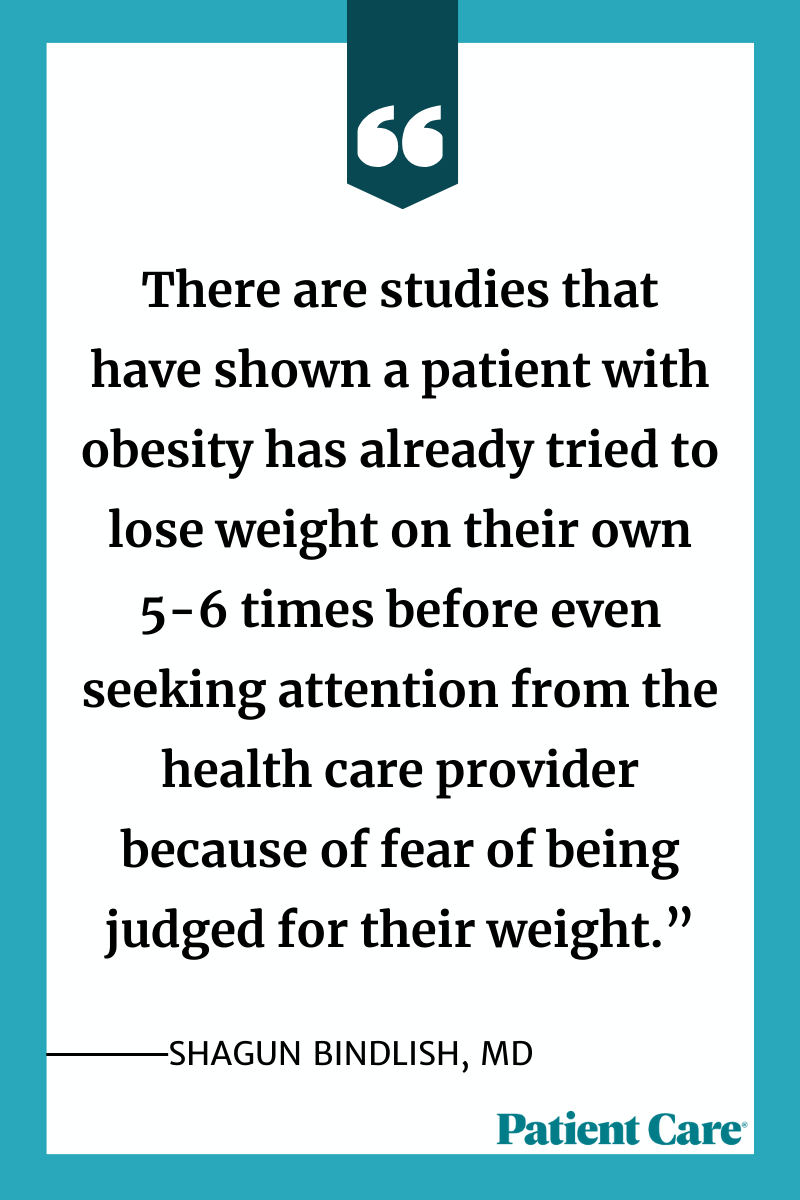
- Clinical Technology
- Adult Immunization
- Hepatology
- Pediatric Immunization
- Screening
- Psychiatry
- Allergy
- Women's Health
- Cardiology
- Pediatrics
- Dermatology
- Endocrinology
- Pain Management
- Gastroenterology
- Infectious Disease
- Obesity Medicine
- Rheumatology
- Nephrology
- Neurology
- Pulmonology
Three Obesity-Related Comorbidities and Management Guidance for Primary Care
Get details on the relationship between obesity and mental health conditions, chronic pain, and hypertension, here.

Obesity, recognized as a chronic disease by the American Medical Association in 2013, is a growing concern in the US as rates have been increasing steadily in recent years. According to the latest data from the US Centers for Disease Control and Prevention (CDC), the prevalence of obesity in adults increased from 30.5% in 1999-2000 to 41.9% in 2017-March 2020.1 Obesity is also common in children and adolescents, with 19.7% of US youths aged 2 to 19 years meeting the CDC’s criteria for obesity, which is a body mass index (BMI) at or above the 95th percentile for age and sex.2
Obesity is a risk factor for a host of other serious health conditions including cardiovascular disease (eg, hypertension [HTN]), type 2 diabetes, musculoskeletal conditions (eg, osteoarthritis), and mental health conditions such as depression and anxiety. Obesity and its related comorbidities are often managed in the primary care setting, making the role of primary care clinicians crucial in early detection and prevention of these conditions.3 To gain deeper insights into the complex connections between obesity and related comorbidities, Patient Care Online recently sat down with 3 experts in obesity medicine to discuss the relationship between obesity and mental health conditions, chronic pain, and HTN.
Mental health
“Obesity is associated with a significant psychological burden,” Shagun Bindlish, MD, said in an interview with Patient Care Online. “Many individuals with obesity struggle with issues related to mood, self-esteem, quality of life, and body image,” Bindlish, who is a board member of the American Diabetes Association and the medical director at One Medical in Dublin, California, said.
Bindlish continued: "Over recent decades, both obesity rates and the prevalence of mental health disorders have increased and sparked intense scientific interest in unfolding the intricate relationship between the 2 seemingly distinct entities.”
Mental health and obesity have been shown to affect each other. For example, a systematic review and meta-analysis of 15 studies found a reciprocal link between obesity and depression: obesity at baseline increased the risk of onset of depression (unadjusted OR 1.55, 95% CI 1.22-1.98; P < .001) and depression increased the odds for developing obesity (OR 1.58, 95% CI 1.33-1.87; P < .001).4
Also, high rates of obesity have been observed in populations with mood disorders, schizophrenia, attention-deficit hyperactivity disorder (ADHD), and trauma. Factors that impact both obesity and mental illness include systemic inflammation, coping behaviors, neurotransmitter levels, and sociodemographic influences (eg, poverty).5

Role of societal stigma
The social stigma surrounding obesity can contribute to depression, anxiety, and low self-esteem, especially among women with obesity. In 2020, an international consensus statement on obesity stigma reported a 19% to 42% prevalence of weight discrimination among adults with obesity. Rates were higher for those with higher BMI and women. The statement also reported that approximately 40% to 50% of US adults with overweight and obesity experience internalized weight bias, about 20% of them at high levels.
Individuals with obesity may experience weight bias both in and outside of the clinic. “Persons with obesity have to face discrimination not only in their home, but in several different settings such as education, employment, and even health care settings,” said Bindlish in another interview with Patient Care Online. “There are studies that have shown a patient with obesity has already tried to lose weight on their own 5-6 times before even seeking attention from the health care provider because of fear of being judged for their weight.”
How can clinicians effectively address the mental health needs of patients with obesity while ensuring a weight bias-free environment?
“We must ask open-ended questions without being judgmental by choosing ‘people first’ language,” Bindlish said to Patient Care. “In addition, a multidisciplinary approach to management that is tailored to individual patient needs shows our motivation and support to the patient.” This includes educating patients on available resources, working together with a nutritionist or a health coach, and referring to bariatric surgeons if needed, Bindlish added.
Check out part 1 and part 2 of our interview with Dr Bindlish for more information on obesity and mental health.
Chronic pain
“Obesity and chronic pain go hand in hand,” Monu Khanna, MD, dually board-certified in internal medicine and obesity medicine and current chair of the Obesity Medicine Association’s Diversity, Equity, and Inclusion Committee, said in an interview with Patient Care Online. “They have a bidirectional relationship; one leads to the other and vice versa.”
Studies have shown an increased prevalence of chronic pain in patients with obesity. In a survey conducted between 2008 and 2010, 1 062 271 randomly selected individuals in the US participated in a telephone interview. Questions included height and weight, pain conditions in the past year, and pain experience yesterday. Based on their height and weight measurements, participants were categorized into the following groups6:
- Low-normal BMI (<25 kg/m2)
- Overweight (25-<30 kg/m2)
- Obesity I (30-<35 kg/m2)
- Obesity II (35-<40 kg/m2)
- Obesity III (≥40 kg/m2)
According to the results, BMI and pain experienced yesterday were reliably associated when researchers controlled for demographic variables. Compared to participants in the low-normal group, 20% more pain was reported in the overweight group, 68% more in the obesity I arm, 136% more in obesity II, and 254% more in obesity III.6
Obesity forces significant stress on weight-bearing joints, leading to conditions like osteoarthritis and arthritis. Moreover, obesity-related postural changes contribute to and exacerbate pain in the lower back, legs, and feet. Physical inactivity, often associated with obesity, leads to muscle weakness, joint stiffness, and decreased flexibility, all of which contribute to chronic pain, Khanna told Patient Care.
“There could also be components of emotional eating, where patients are trying to soothe themselves with food. We all know when we’re feeling stressed out, we’re looking for a quick fix, aka processed foods,” Khanna said. Processed foods are high in sugar and fat, which can cause inflammation and pain in patients with obesity, she explained.
Chronic pain also limits physical activity, which can lead to further weight gain, perpetuating obesity. This creates a vicious cycle where pain and obesity exacerbate each other, complicating both conditions' management. It is important for clinicians to understand the complex relationship between the 2 conditions to provide personalized and effective care for their patients, Khanna said.
Pharmacologic options for management of chronic pain—such as nonsteroidal anti-inflammatory drugs (NSAIDs), opioids, prednisone, gabapentin, and pregabalin—may be a double-edge sword for patients with obesity and pain, according to Khanna. “The same pain medication that is bringing relief to the patient is creating more weight gain as well as excessive appetite, so we’re not fixing the root cause,” Khanna told Patient Care. For this reason, nonpharmacologic options such as massage, acupuncture, yoga, and physical therapy are an effective addition to the treatment.
Hypertension
Obesity is a known risk factor for hypertension (HTN). Findings from the Framingham Heart Study showed that 78% of primary HTN in men and 65% in women can be attributed to obesity.7
Obesity directly impacts HTN through several mechanisms, including sympathetic nervous system overactivation, stimulation of the renin-angiotensin-aldosterone system which primarily functions to help maintain healthy blood pressure, changes in adipose-derived cytokines, insulin resistance, and structural and functional renal changes.8
In terms of assessing and managing HTN in patients with obesity, there are no clear obesity-directed HTN guidelines for clinicians to follow, according to Jonathan Parker, DO, MS, president of the Alabama Obesity Society. Common treatments for HTN include thiazide diuretics, beta blockers, angiotensin receptor blockers (ARBs), and angiotensin-converting enzyme (ACE) inhibitors, Parker told Patient Care Online. Some of these medications, however, may not be the best first line treatment choice for patients with obesity.
“The difficulty with prescribing thiazide diuretics to patients with obesity is they are linked to increased glucose and insulin resistance so those tend to fall out of favor as first-line in patients with obesity,” Parker stated. “Older beta blockers tend to block beta-adrenergic receptors in adipocytes, which makes burning fat difficult and hinders weight loss.” For this reason, Parker recommends third generation beta blockers such as nebivolol and carvedilol in place of older ones.
ACE inhibitors and ARBs are a more effective option for patients with obesity because they are weight neutral. This benefit extends to those with coexisting HTN and diabetes. “A high rate of patients with obesity also have diabetes, so of course, if a patient has HTN and diabetes, ACE inhibitors and ARBs are a go-to medication for treating HTN because of their renal protection,” said Parker.
How can clinicians approach educating patients with obesity on how the condition contributes to the development and worsening of HTN? Parker recommends a “weight-first approach” instead of immediately prescribing medication. “A kilogram of weight loss results in a drop of about 1 mm Hg of blood pressure. So, if you treat a patient’s weight first, their blood pressure is going to improve,” he said.
Parker also emphasized the importance of talking to patients compassionately and calmly without putting the blame on them.
“I cannot say this enough: Patients have been so attacked when it comes to their weight,” Parker stated. “Providers are either afraid to bring it up or attack and blame their patients…if we can compassionately, calmly talk to our patients using objective language and tell them it is not their fault, then absolutely, they would want to be engaged with their provider about their weight.”
A note to primary care
Obesity and its related comorbidities can present a complex and intertwined challenge to primary care clinicians. How can clinicians effectively navigate this relationship and provide effective management for patients?
“By bringing the HOPE,” Bindlish said to Patient Care Online. “’H’ stands for health care: we need to address the health care need and associated comorbidities. ‘O’ is for optimism and open, unbiased communication to help build a rapport with patients. ‘P’ is for perseverance…and ‘E’ is for empathy and understanding the emotional behaviors of patients with obesity such as eating comfort food.”
References:
- Adult obesity facts. Centers for Disease Control and Prevention Web site. https://www.cdc.gov/obesity/php/data-research/adult-obesity-facts.html. Updated May 14, 2024. Accessed July 1, 2024.
- Childhood obesity facts. Centers for Disease Control and Prevention Web site. https://www.cdc.gov/obesity/php/data-research/childhood-obesity-facts.html. Updated April 2, 2024. Accessed July 1, 2024.
- Tucker S, Bramante C, Conroy M, et al. The most undertreated chronic disease: Addressing obesity in primary care settings. Curr Obes Rep. 2021;10:396-408. doi:10.1007/s13679-021-00444-y
- Luppino FS, de Wit LM, Bouvy PF, et al. Overweight, obesity, and depression: A systematic review and meta-analysis of longitudinal studies. Arch Gen Psychiatry. 2010;67:220-229. doi:10.1001/archgenpsychiatry.2010.2
- Taylor VH, McIntyre RS, Remington G, et al. Beyond pharmacotherapy: understanding the links between obesity and chronic mental illness. Can J Psychiatry. 2012;57:5-12. doi:10.1177/070674371205700103
- Stone AA, Broderick JE. Obesity and pain are associated in the United States. Obesity (Silver Spring). 2012;20:1491-1495. doi:10.1038/oby.2011.397
- Garrison RJ, Kannel WB, Stokes J 3rd, Castelli WP. Incidence and precursors of hypertension in young adults: The Framingham Offspring Study. Prev Med. 1987;16:235-251. doi:10.1016/0091-7435(87)90087-9
- Shariq OA, McKenzie TJ. Obesity-related hypertension: A review of pathophysiology, management, and the role of metabolic surgery. Gland Surg. 2020;9:80-93. doi:10.21037/gs.2019.12.03
2 Commerce Drive
Cranbury, NJ 08512
All rights reserved.